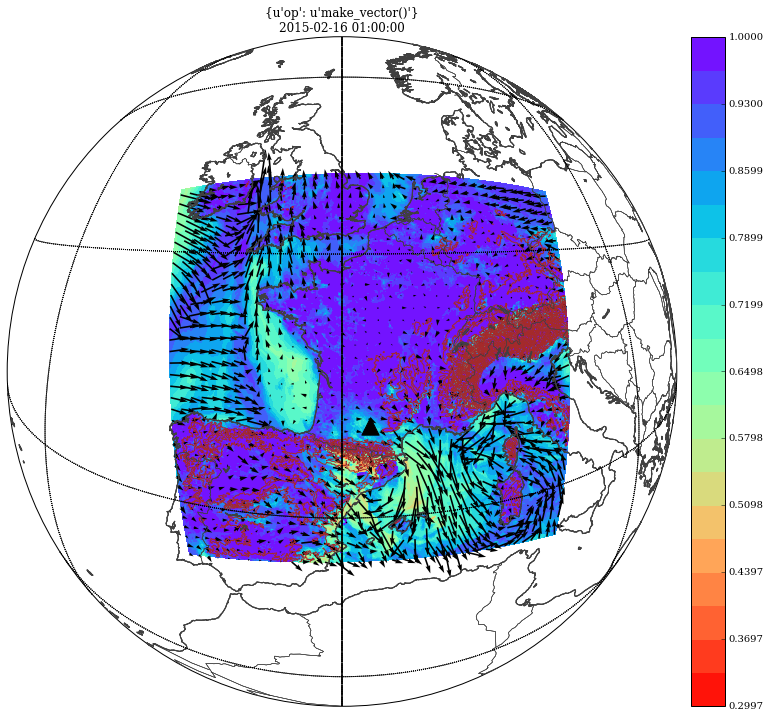5.1. Advanced plotting¶
Let’s plot a composition with orography as contourlines, relative humidity at 2m, wind at 10m and add also superpose the location of an observation on top of that
[1]:
%matplotlib inline
import os
import epygram
epygram.init_env() # initialisation of environment, for FA/LFI and spectrals transforms sub-libraries
workdir = epygram.config.userlocaldir + '/notebooks_data'
os.chdir(workdir)
[2]:
fcst1 = epygram.formats.resource('advanced_examples/ICMSHAROM+0001', 'r')
[3]:
fcst1.find_fields_in_resource('CLS*') # look for all CLS fields
[3]:
[u'CLSVENT.ZONAL',
u'CLSVENT.MERIDIEN',
u'CLSTEMPERATURE',
u'CLSHUMI.RELATIVE',
u'CLSHUMI.SPECIFIQ',
u'CLSMINI.TEMPERAT',
u'CLSMAXI.TEMPERAT',
u'CLSU.RAF.MOD.XFU',
u'CLSV.RAF.MOD.XFU']
[4]:
rh2m = fcst1.readfield('CLSHUMI.RELATIVE') # relative humidity at 2m
u10 = fcst1.readfield('CLSVENT.ZONAL') # zonal wind at 10m
v10 = fcst1.readfield('CLSVENT.MERIDIEN') # meridian wind at 10m
[5]:
orog = fcst1.readfield('SPECSURFGEOPOTEN') # surface geopotential
orog.spectral
[5]:
True
[6]:
orog.sp2gp()
orog.spectral
[6]:
False
[7]:
orog.operation('/', 9.81) # convert geopotential to orography
[8]:
obs = epygram.formats.resource('advanced_examples/Toulouse_2015-02-16.nc', 'r') # an obs file at Toulouse
[9]:
obs.listfields()
[9]:
[u'time',
u'P_AIR',
u'T_AIR_ABRI_5M',
u'FLAG_T_AIR_ABRI_5M',
u'HU_AIR_ABRI_5M',
u'HUMSPEC_ABRI_5M',
u'RAY_RGM',
u'RAY_RGD',
u'RAY_IRM',
u'RAY_IRD',
u'TPR_SOL_3CM',
u'DD_GILL_2.5M',
u'FF_GILL_2.5M',
u'FLAG_GILL_2.5M',
u'DD_GILL_5M',
u'FF_GILL_5M',
u'FLAG_GILL_5M',
u'DD_GILL_7.5M',
u'FF_GILL_7.5M',
u'FLAG_GILL_7.5M',
u'DD_GILL_10M',
u'FF_GILL_10M',
u'FLAG_GILL_10M',
u'longitude',
u'latitude']
[10]:
rh5m_obs = obs.readfield('HU_AIR_ABRI_5M') # read a series of relative humidity on obs point
print(type(rh5m_obs))
<class 'epygram.fields.PointField.PointField'>
[11]:
print(len(rh5m_obs.validity))
print(rh5m_obs.validity[0].get(), '--->', rh5m_obs.validity[-1].get())
1440
(datetime.datetime(2015, 2, 16, 0, 1), '--->', datetime.datetime(2015, 2, 17, 0, 0))
[12]:
rh5m_obs = rh5m_obs.getvalidity(rh2m.validity[0]) # extract the point at the validity of the model
print(rh5m_obs.validity.get())
2015-02-16 01:00:00
[13]:
# pre-compute the basemap, more efficient, with specific 'near-sided perspective' projection
bm = orog.geometry.make_basemap(specificproj=('nsper', {'sat_height':600, 'lon':0, 'lat':45.6}))
# recompose wind vector field
wind = epygram.fields.make_vector_field(u10, v10)
# compute coordinates of the obs in the basemap referential
x, y = bm(rh5m_obs.geometry.grid['longitudes'], rh5m_obs.geometry.grid['latitudes'])
[14]:
# plot orography
fig, ax = orog.plotfield(use_basemap=bm,
graphicmode='contourlines',
levelsnumber=9,
minmax=(500, 4500),
contourcolor='brown',
contourlabel=None,
subzone='C')
# plot relative humidity
fig, ax = rh2m.plotfield(over=(fig,ax), use_basemap=bm,
graphicmode='colorshades',
colormap='rainbow_r',
subzone='C')
# plot wind
fig, ax = wind.plotfield(over=(fig, ax), use_basemap=bm,
plot_module=False,
symbol='arrows',
subsampling=20,
subzone='C')
# plot the obs
bm.scatter(x, y, s=300, c='black', marker='^', ax=ax)
[14]:
<matplotlib.collections.PathCollection at 0x7febc9eab910>
